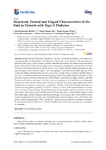Mostrar o rexistro simple do ítem
Structural, dermal and ungual characteristics of the foot in patients with type II diabetes
| dc.contributor.author | González-Martín, Cristina | |
| dc.contributor.author | Pértega-Díaz, Sonia | |
| dc.contributor.author | Seoane-Pillado, Teresa | |
| dc.contributor.author | Balboa-Barreiro, Vanesa | |
| dc.contributor.author | Soto, Alfonso | |
| dc.contributor.author | Veiga-Seijo, Raquel | |
| dc.date.accessioned | 2020-01-14T11:44:59Z | |
| dc.date.available | 2020-01-14T11:44:59Z | |
| dc.date.issued | 2019-09-25 | |
| dc.identifier.citation | González-Martin C, Pértega-Díaz S, Seoane-Pillado T, Balboa-Barreiro V, Soto-González A, Veiga-Seijo R. Structural, dermal and ungual characteristics of the foot in patients with type II diabetes. Medicina. 2019; 55(10):639. | es_ES |
| dc.identifier.issn | 1648-9144 | |
| dc.identifier.uri | http://hdl.handle.net/2183/24619 | |
| dc.description.abstract | [Abstract] Background and Objectives: Diabetes is a chronic and metabolic disease, considered as an important public health problem. The objective of this study was to determine the prevalence of podiatric pathology in type II diabetic patients. Materials and Methods: An observational descriptive study of prevalence in the endocrinology service of Complexo Hospitalario Universitario A Coruña (CHUAC) (A Coruña-Spain) was carried out (n = 153). Type II diabetic patients included, of legal age who signed the informed consent. Sociodemographic variables were studied (age, sex, body mass index (BMI), smoking habit, alcohol consumption, family history), disease variables (time of evolution of diabetes, treatments, low-density lipoprotein (LDL), high-density lipoprotein (HDL), glucose), podiatric variables: measurement of the footprint, metatarsal and digital formula, nail, skin, hindfoot and forefoot alterations. The data collection was done in 2018 and the data analysis was carried out in 2019. Results: The patients with type II diabetes had greater age, obesity and arterial hypertension it compared to the general population. Diabetic patients had a higher prevalence of flat feet than the general population (71.2% vs. 20.7%, p < 0.001), with a predominance of normal foot according to the podoscope. The predominant podological pathology was the presence of claw toes (94.8%), followed by dermal (78.4%) and nail (71.9%) alterations, and the Hallux Valgus (66.0%). The Clarke angle and the Chippaux index showed a Kappa concordance index of 0.26 with the type of footprint measured with the podoscope. The Staheli index showed a Kappa index of 0.27 associated with an observed agreement of 54%. Conclusions: This study shows that foot problems continue to be prevalent in subjects with type II diabetes mellitus and for this reason, podiatry is essential in its treatment. | es_ES |
| dc.language.iso | eng | es_ES |
| dc.publisher | MDPI | es_ES |
| dc.relation.uri | https://doi.org/10.3390/medicina55100639 | es_ES |
| dc.rights | Atribución 3.0 España | es_ES |
| dc.rights.uri | http://creativecommons.org/licenses/by/3.0/es/ | * |
| dc.subject | Foot | es_ES |
| dc.subject | Diabetes | es_ES |
| dc.subject | Podiatry | es_ES |
| dc.title | Structural, dermal and ungual characteristics of the foot in patients with type II diabetes | es_ES |
| dc.type | info:eu-repo/semantics/article | es_ES |
| dc.rights.access | info:eu-repo/semantics/openAccess | es_ES |
| UDC.journalTitle | Medicina | es_ES |
| UDC.volume | 55 | es_ES |
| UDC.issue | 10 | es_ES |
| UDC.startPage | 639 | es_ES |
Ficheiros no ítem
Este ítem aparece na(s) seguinte(s) colección(s)
-
INIBIC-ECB - Artigos [50]






